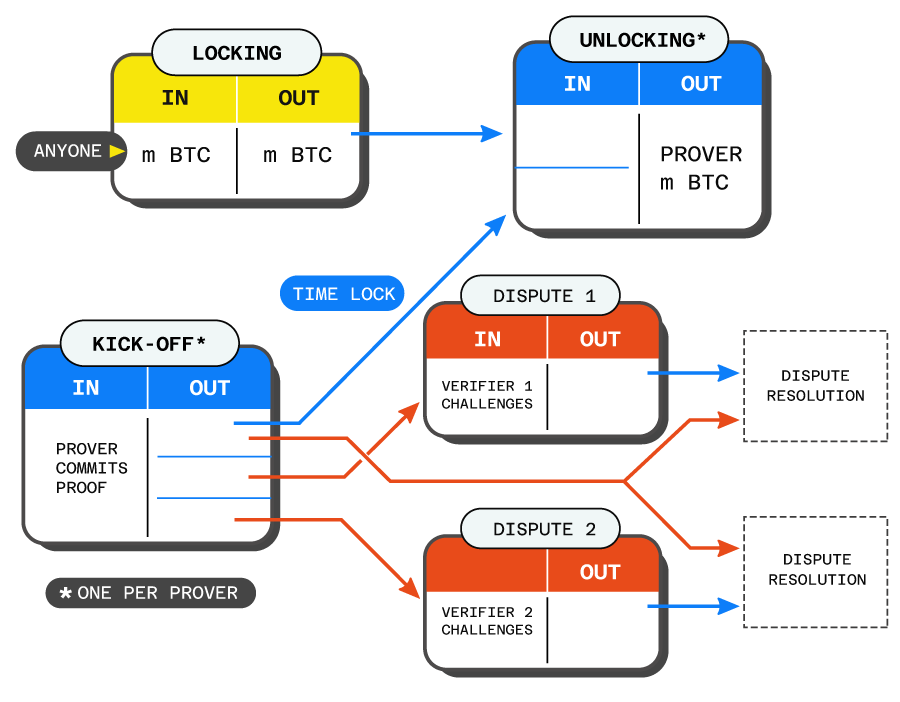Union Bridge: A Trust-Minimized Bitcoin Bridge

How Fairgate is redefining cross-chain security and interoperability with BitVMX
Cross-chain interoperability is a critical challenge in the blockchain ecosystem, especially when it comes to bridging Bitcoin with other networks. Existing solutions often rely on centralized intermediaries, exposing users to counterparty risks and censorship concerns. At Fairgate, in collaboration with Rootstock Labs, we set out to tackle this issue by developing the Union Bridge —a trust-minimized bridge, based on BitVMX, between Bitcoin and Rootstock.
Understanding the Challenge of Bitcoin Interoperability
Bitcoin is widely regarded as the most secure and decentralized blockchain network. Its design, rooted in simplicity and robustness, has allowed it to serve as the most trusted store of value in the digital realm — a reputation that has earned it the title of "digital gold." This foundation has propelled Bitcoin to its status as the dominant blockchain. However, its original focus on security and decentralization comes at a cost: Bitcoin lacks native programmability and cross-chain communication capabilities.
As the broader blockchain ecosystem has evolved — embracing decentralized finance (DeFi), smart contracts, and other programmable innovations — the limitations of Bitcoin’s base layer have become more apparent. A growing number of users and developers seek to use Bitcoin in more expressive and interactive ways, from participating in DeFi protocols to deploying BTC in smart contract-based systems. Yet Bitcoin cannot support these functionalities directly.
To overcome these constraints, users have turned to bridging mechanisms that allow BTC to move into programmable environments like Rootstock. Rootstock not only supports Turing-complete smart contracts, but also offers a growing suite of DeFi protocols, decentralized applications, and developer tooling. By bridging to Rootstock, BTC holders can access a broader financial ecosystem while preserving the underlying asset's security, liquidity, and monetary integrity.
Union Bridge
Union employs a multi-party variant of BitVMX, an optimistic proving system on Bitcoin, to create a bridge that operates securely under the assumption that at least one participant remains honest.
However, this path introduces a new set of challenges — particularly around trust. Most existing Bitcoin bridges are custodial or semi-custodial, relying on centralized entities or federated multi-signature groups to lock BTC and issue wrapped assets. This model introduces several critical risks:
- Custodial Risk: Funds can be lost or mismanaged through internal failures or external attacks.
- Censorship Risk: Centralized actors can restrict or freeze transactions, undermining financial sovereignty.
- Security Vulnerabilities: Custodial bridges have become high-value targets for exploits, with several prominent hacks exposing flaws in their security models.
These risks are fundamentally at odds with Bitcoin’s trust-minimized ethos.
The real challenge, then, is to create a bridge architecture that upholds Bitcoin’s principles while enabling interoperability. Such a system must ensure that when users lock BTC, as the initial step in the bridging procedure, they retain the ability to redeem it — securely, and without relying on intermediaries. This architecture must also provide mechanisms to verify external events without the aid of smart contracts or native cross-chain functionality within Bitcoin itself. This is the problem that innovations like BitVMX and Union Bridge are designed to solve.

Transaction graph structure for multi-party BitVMX showing the Locking, Kickoff, dispute, and Unlocking transactions
The Fairgate Solution: BitVMX-Powered Security
To address all these issues, Fairgate leverages BitVMX, an innovative verification framework that enables Bitcoin to optimistically verify events occurring on other networks—without relying on trusted intermediaries. BitVMX uses an off-chain execution model coupled with on-chain fraud proofs, allowing Bitcoin to securely interact with external systems while preserving its native trust guarantees.
Union Bridge introduces a new permission-less model for cross-chain interaction — one that eliminates reliance on trusted third parties. Anyone can become a watchtower of the bridge and guard against fraud, by placing a small security bond.
Union Bridge achieves this through a combination of powerful technologies:
- BitVMX fraud proofs, which verify peg-out requests and prevent unauthorized fund releases.
- Taproot, enabling expressive, private Bitcoin scripts for complex bridge logic.
- Zero-knowledge proofs, which confirm cross-chain actions without exposing private data.
- Best chain proofs and counter-proofs, similar to the original Blockstream’s sidechains design.
- A new Rootstock super-chain which provides succinct confirmations of large Rootstock chains reducing the ZK proving time of Rootstock events, similar to NiPoPoWs.
- Cross-chain relays, which synchronize Bitcoin and Rootstock by submitting transaction proofs across chains.
Union Bridge masterfully orchestrates these technologies and it works as follows:
- A user locks BTCs on the Bitcoin main chain and receives a wrapped version of the BTCs on Rootstock (RBTC).
- When any user wants to redeem their BTCs, they initiate a burn of the equivalent amount of RBTCs on Rootstock.
- If all watchtowers approve, the funds are withdrawn directly to the user’s Bitcoin wallet. This is the most common outcome, known as the “happy path”.
- If any watchtower refuses to approve, then the Bridge chooses one operator willing to front the funds to the user.
- The operator fronts the funds and builds a succinct proof that attests it, then kicks-off the reimbursement protocol by presenting this proof in a Bitcoin transaction.
- BitVMX facilitates the optimistic verification of the funds fronting proof — assuming it is valid unless a fraud proof is submitted.
- If no watchtower challenges the proof during the challenge window, the corresponding BTCs are released from the vault and returned to the operator. This would be the most common case of fronting, possibly because a watchtower missed its approval, for being temporarily out of service. Therefore this represents a second opportunity for a “happy path”.
- If fraud is truly happening, it will be detected by a watchtower. who can submit a valid fraud proof to Bitcoin. This triggers an on-chain dispute resolution process, which automatically halts the release of funds and penalizes the operator for fraud — typically by slashing their security deposit.
- The invalid transaction is rejected, and the bridge remains secure, with user funds protected from unauthorized withdrawals.
This fraud-proof mechanism ensures that all peg-out requests are subject to public validation, and that dishonest behavior is economically disincentivized — maintaining trustlessness without needing centralized control.
The Future of Bitcoin Bridges
As a growing constellation of specialized blockchains emerges, we believe Bitcoin will remain the dominant chain — the most secure, decentralized, and economically significant foundation in the ecosystem. As its role evolves from a store of value to a base layer for decentralized applications, secure and trust-minimized connectivity with other networks becomes essential.
BitVMX-powered bridges like Union Bridge make this possible. They extend Bitcoin’s functionality without compromising its core principles, enabling it to interoperate seamlessly with, application-specific chains. Rather than reshaping Bitcoin to fit a multi-chain world, this approach builds around it — reinforcing its centrality through layered, trustless innovation.
Ultimately, Union Bridge helps position Bitcoin as a powerful base layer for decentralized applications — extending its reach without compromising the integrity of its design.
At Fairgate, we're committed to building secure, scalable infrastructure that preserves Bitcoin’s trustless nature. With Union Bridge, we're one step closer to seamless cross-chain interoperability grounded in decentralization.
To learn more or get involved, visit bitvmx.org
— Jonatan Altszul, CEO of Fairgate





